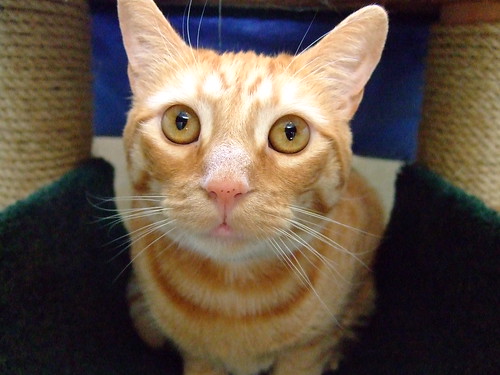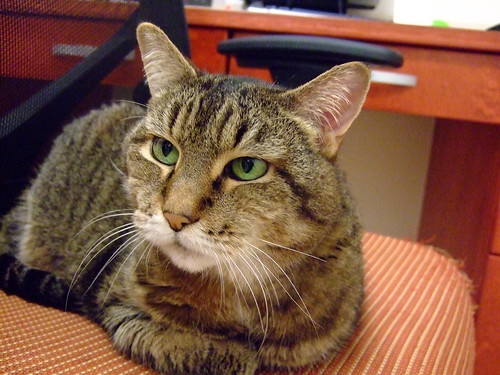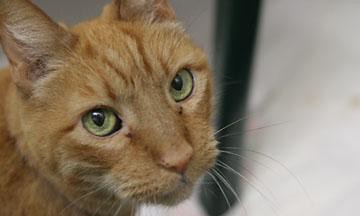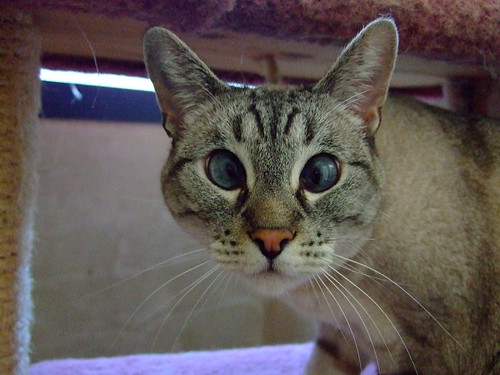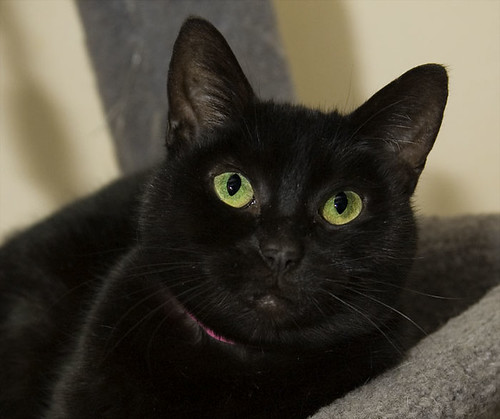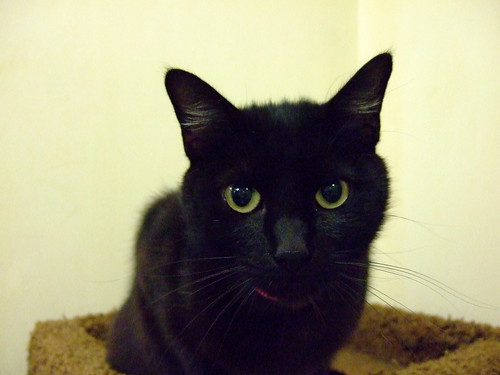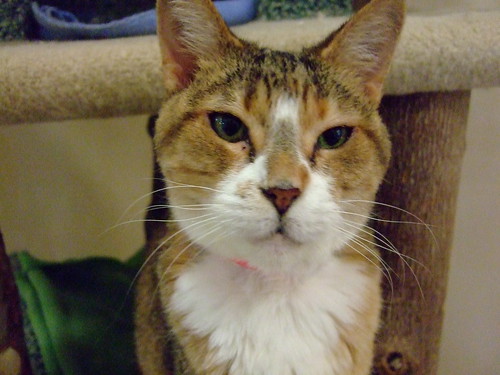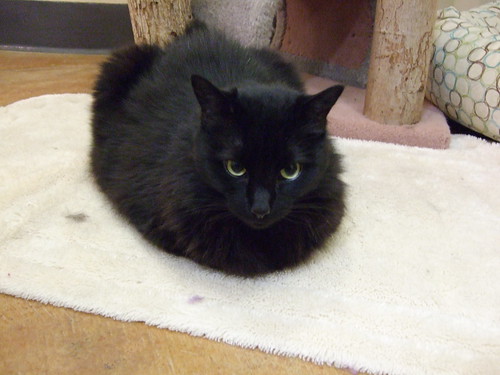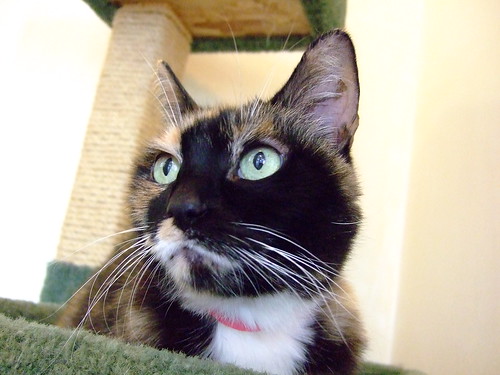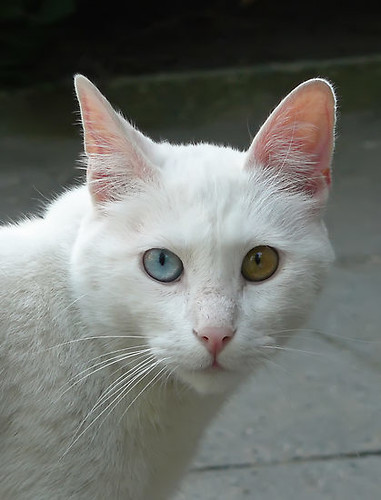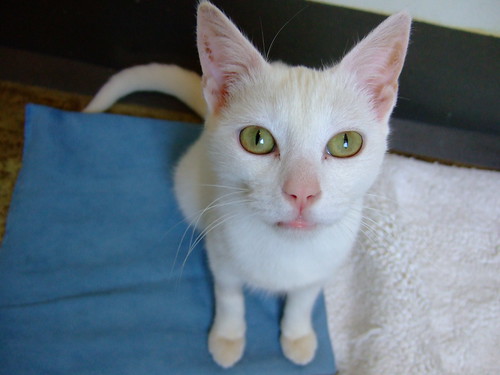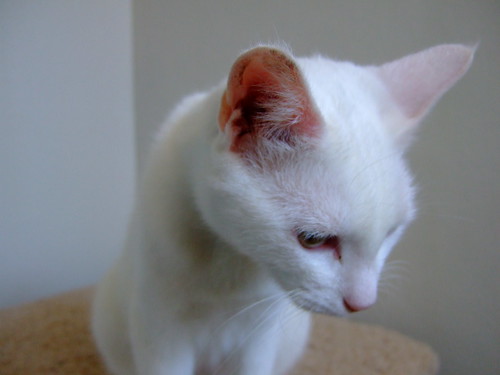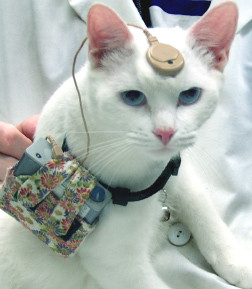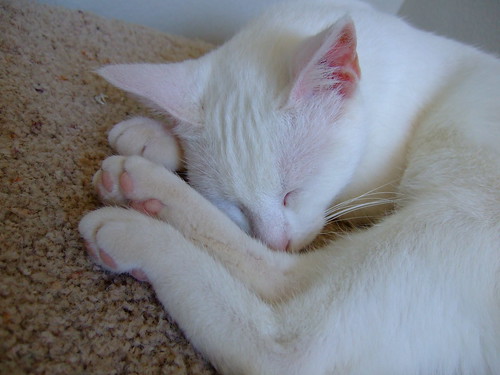Friday, July 31, 2009
Video Extravaganza!!!!!
Monday, July 27, 2009
Ahoy Matey! Cats on Boats?
Tuesday, July 21, 2009
Tessa's Time To Shine
There are common stimuli that can drastically cause anxiety in a cats behavior:
- Arrival of a stranger
- Intrusion into their personal space
- Sudden movements
- Loud noises
- Novel objects
- Novel smells
- Loss of control over the environment
- The arrival of other cats
This was definitely the case with Tessa. Her harsh reaction to virtually all of these stimuli (except for other cats)made the case very clear. Tessa was indeed having a very hard time adjusting to the drastic changes in her life's routine. So what do you do in cases like this?
Initially, we tried to desensitise her to the strangers, having them spend more and more time with her , especially during feedings. With her hesistance to people coming and going becoming an issue, the visitors who stayed longest seemed to be her favorite. Tessa showed us her discomfort by rolling around on the floor, showing her belly and purring like a motor. Progress!!!!The next step was to move Tessa into an environment with consistancy. We wanted to immerse her in a room where people would stay longer than just few minutes to half an hour and be able to work with her socialization on a continuous basis, making every meal count. The next obvious place to live would be our office!
We moved Tessa in last week and so far things are really looking up! She walks freely around the room and has adjusted really well to the comforts of our office. Like a true diva kitty, Tessa has us wrapped around her fingers, catering to her every whim. It's a welcome distraction to our daily tasks and so worth the reward. Tessa is well on her way to being the shy but loving house cat that she once was.
If you are interested in keeping up with Tessa's progress or would like to take her home to live with you, feel free to email The Cat Behavior Program at catbehavior@sfspca.org
Monday, July 20, 2009
Senior Moments: Caring for your elderly cat
After yet another visit to the veterinarian with my 18 year old cat; Matilda, I decided it may be a good time to address what it's like to care for a senior cat. You may remember Matilda from previous posts such as : My Alarm Clock Is Hungry & My Cat Made Me Do It. This time around, the exam shows the onset of kidney disease. As it is, I give Matilda subcutaneous fluids a few times a week to keep her well hydrated and functioning as normal as possible. Although, Matilda habitually defies normalcy, as you can see in her other stories. Her failing health, coupled with cognitive dysfunction (Catzheimers) make caring for her a lesson in life's mysteries.
Sure, there are challenges, disappointments, reality checks and unknown territory behind every corner, but I have news for you.... Some day, your cat will grow old too and it will suddenly occur to you that kitty is not the sharp, nimble footed acrobat s/he once was. Caring for elderly cats is not as bad as some make it out to be. It's just life's reminder that nothing lasts forever. Why not help your cat along the way with dignity and grace?
When is a cat considered a senior?
Cats often initially show age related physical changes between the ages of seven and ten years. Most human companions will notice differences, both physically and behaviorally in their cat, by the time the kitty is twelve. In my case, I started to see signs of aging in Matilda around fifteen. It's been a long three years since then!
You may notice some of these common signs of aging in your cat:
Many cats will have some difficulty jumping or climbing onto higher surfaces due to arthritis.
- Your cat may be less diligent about grooming himself. (Their hair can appear matted or greasy)
- Changes (in environment or routine) may be more difficult to adjust to.
- Increased vocalization, or meowing is louder than usual.
- Your cat may sleep more (ok, more than usual).
- Decrease in energy and zest for play.
- Change in appetite or refusal to eat.
- Litter box avoidance or aversion.
- An increase in aggression due to pain or confusion.
- Some cats become more relaxed and mellow, and may be more accepting of petting or medicating.
Ways to Accommodate an Older Cat’s Special Needs
For cats with arthritis or joint pains, ramps or stairs covered with carpeting are helpful to make access to sofas, beds, or other favorite resting places easier. There are also elevated food and water dishes available if your kitty has trouble with neck pain.
If your kitty is not grooming well, you will need to help out. Matted coats, particularly on long-haired cats are unhealthy and uncomfortable. Regular grooming is good for their fur and for skin-circulation, and many cats enjoy being brushed. Try a few different style brushes to see which your cat prefers.
Hear no evil, See no evil, Taste no evil
As hearing and sight become less acute, you may notice you cat lumbering around the house or even hiding as a result. Adding night lights or providing extra light in general is a thoughtful accommodation. If blindness appears suddenly, then it will be more obvious with the cat noticeably bumping into furniture or walls. Restricting territory or padding sharp corners of low furniture will prevent injury. In the case of hearing loss, a lack of response to sounds, coming when called (most cats ignore you anyway), or an increased vocalization or disorientation may also be apparent.
Some cats will become picky about food. This is best discussed with a veterinarian as it can indicate a tooth/gum condition or other health problem. However, some elderly pets may just need to be tempted to eat. It can help to feed smaller, more frequent meals. They may be more responsive to fresh food, or food that has been gently heated, as they can often smell it better. Older cats need to drink plenty of water, and it may be necessary to try several different water sources to insure they are drinking.
Routine is the key!
Adjusting to sudden change is difficult for most cats, but more so for older kitties. Make any changes in the environment or routine gradually. Something as simple as a variation in daily schedules can be an upset. Trying to keep as much routine as possible for your cat will be very helpful in reducing stress. This means keeping cat bedding and furniture in its usual place, and having regular times for feeding, cuddling, grooming and other interactions each day.
Gentle exercise is a great stress reducer and can maintain health. This gives them a chance for mental stimulation without a lot of physical activity. Having a spot in a sunny window to observe outdoor wildlife might be fun, too.
Preventative and Basic Care
Your senior pet should have a full examination by a veterinarian every six months, even if she seems perfectly healthy. If medical problems are diagnosed and treated early on, the treatment may be more effective and less costly. Some degenerative processes can be slowed down when detected early. These regular check-ups are the time for you to discuss with your vet any changes in behavior, appetite or sleeping habits.
We love them when they are kittens, but when they grow old they need us most. Shelters across the country have many senior cats that are looking for compassionate humans to watch over them in their golden years. Please check out amazing cats like MONKEY!
MONKEY 16 yr old with plenty of pep!
Friday, July 17, 2009
HOT, HOT, HOT! The SF/SPCA Summer Guide for Pets
Here's the SF/SPCA's top 10 list for you to keep in mind as you enjoy the summer with your family, two- and four-footed. Our Veterinary Hospital provides many of the services recommended on the list from micro-chipping to heart-worm testing, from emergency care to boarding services...consider us one of the family with our experienced team of compassionate and caring medical staff.
For the sake of fairness, Litter Did You Know will also be addressing dog safety.
- Never leave your dog/cat in the car—even with windows cracked down—on hot days. The temperature can rise in minutes with deadly results. Learn to recognize the symptoms of heat stroke which include profuse panting, salivation, warm dry skin, rapid heartbeat, high fever, vomiting, muscle weakness, inability to move, and collapse. Always carry your veterinarian's telephone number; better yet program it into your cell phone.
- Keep your vaccines up-to-date. Core vaccines are recommended for all dogs and cats against serious and sometimes fatal diseases, which are common in all areas of the United States.
Install screens in household windows and doors, to assist in preventing cats and dogs from falling accidents and exploring the outside world. - Be certain dogs/cats are microchipped and wear ID tags. Be sure both are current on address/telephone number information. All cats and dogs adopted from The SF/SPCA come already microchipped. If your animal is not "chipped", schedule an appointment today.
- Learn about pet-friendly gardening options. Summer is time when many will use plant fertilizer and pesticides which can be harmful and fatal to our house pets. Keep citronella candles, oil products and insect coils out of pets' reach as well.
- Warmer temperatures and dry conditions are perfect for the lifespan of parasites. Consult with your veterinarian regarding flea & tick prevention options. Note that Heartworm, a very serious and possibly fatal disease is transmitted by the mosquito. Be sure to have your animal tested if not on year-round preventative medication. Cats can get heartworm too.
- Keep animals away from foxtails (not the animal, but the vegetation). These bushy, sticky grasses can become embedded in a pet's coat and burrow through the skin into the animal's body causing medical problems. Avoid overgrown lawns and fields while on walks or hiking. Keep your pet's coat well groomed during summer months. Inspect your pet's fur after hiking, including ears, nose and between the toes.
- Use veterinary prescribed sunscreen to prevent burning and skin cancer especially in white dogs, and/or dogs with a fine coat. Apply to noses and tips of ears. Include sunscreen in your Pet First Aid kit/backpack.
- Keep dogs leashed when out and about at summer fairs to avoid dog being lost in a crowd. Only well socialized and well behaved dogs should be included in large group activities. If your dog needs behavior training, register for one of our upcoming classes.
- Consider a vacation location where pets are welcome. If not, do your homework on pet sitting services and boarding facilities well in advance.
For a mountain of information about Summer Health & Safety, GO TO:
http://www.sfspca.org/promotions/summer-health-and-safety.html
Wednesday, July 15, 2009
For The Love of Moe: A cat destined for a lifetime of love
-------------------------------------------------------------------------------------------------
Two years ago, I found myself a bi-pedal companion and adopted him too. He also came with a cat named Tanner. A twenty-five pound bundle of love who loves nothing more than to be held in your arms 24/7. Keith - my human - and I bought a house and moved in together in the Fall of 2008. When we did, we adopted a beautiful Tortoise-shell Siamese. Her name was "Monkey" but it was changed to Madonna Louise Veronica Ciccone. I deny having anything to do with renaming however, "Mage" proved her namesake accurate. In one word: "Diva." Surprisingly, Moe who is very much and alpha male and Madonna who is an alpha female, get along the best. They play often. Who knew?
I thought the SF SPCA would like to know how one of your adoptees is doing. Moe still sleeps with me every night, but no longer next to my head. He now insists upon sleeping ON me. Like most Leos, he loves to be held and scratched and cuddled, but only when no one else is looking. He hides when Ken pays a visit, but I have since stopped calling into question Ken's parentage.
Monday, July 13, 2009
It's a Matter of Felin-ality
Looking to adopt a new cat? If you prefer a cat with a feisty or spunky personality that is vocal, consider a tortoiseshell. Maybe you are better suited to a mellow feline companion. If so, an orange tabby might be a good fit. These, of course, are just generalizations about the various cat breeds and there are many exceptions. Furthermore, every cat, especially an older one, has a history that has influenced its temperament and behavior. But since cats, like people, are not all the same, the odds of a successful, mutually satisfying adoption are better when you match your needs and preferences to the behavior and personality of the cat you add to your home.
The SF/SPCA wants to make sure that you and your new feline companion stay together for a long time, so about a year ago implemented a very unique program called ‘Meet Your Match' developed by the ASPCA, Meet Your Match helps adopters to get a better understanding of each cat and an expectation of how it will fit into a new household.
Daniel Quagliozzi, cat behaviorist at The SF/SPCA, explained that the shelter previously focused only on a cat’s behavior when it arrived at the shelter and did not factor in its personality. Now they do both.
“The first days at the shelter are often extremely stressful for a cat, so an initial assessment might not give you a true picture of the cat’s real personality or how it will adapt to a certain household,” Quagliozzi said. “Meet Your Match attempts to get a more accurate reading of each cat that we place for adoption.”
A few days after a cat arrives at The SF/SPCA, cat behaviorists with the help of volunteers give it a 15-minute assessment to determine how social it is and how well it adapts to new situations and people. Behaviorists put the cat through its paces, timing its cat-to-human approach, grading its reaction to petting and a variety of other tests — including hugging and tail tugging – and how much it interacts during a five-minute period.
Based on the observations and interaction, the shelter assigns each cat one of nine felin-alities, ranging from the independent and cautious ‘Secret Admirer’ to the gregarious and valiant ‘Leader of the Band.’
“Most cats grade out as 'Sidekicks,' a middle-of-the road cat who is social and affectionate and deals fairly well with new situations and enjoys plays,” Quagliozzi said. He also pointed out that a cat’s felin-ality generally begins at about nine months of age.
Each potential cat adopter also takes a survey, which asks questions about the household environment and expectations about interacting with an adopted cat, such as is it important that the cat likes being held or will it need to get on with children or other animals and more.
The San Francisco SPCA would like to thank Barbara Kohn of www.examiner.com for devoting the week to our shelter, especially with the dissapearance of our blind kitten Jack Daniels. Be sure to read her cat column every day!
Friday, July 10, 2009
Fospice Program Gives Cats a Second Chance
In keeping with Barbara Kohn's 3 -part series about the SF/SPCA on http://www.examiner.com/ we are pleased to link you to a really great article about our FOSPICE Program.
"Yo is one cat that knows what he likes. That would include both movie time and bedtime sleeping with his human companion Vaughn Korbin, a San Francisco family law attorney. One might not consider any of these activities out of the ordinary for a cat, especially an orange tabby like Yo, which are known to be highly friendly and affectionate. But Yo isn’t an ordinary cat. This almost 13 year-old, very handsome boy suffers from liver cancer and how much longer Yo will enjoy the care and comfort of life with Korbin is uncertain. Yo is part of a very unique Fospice or “foster hospice’ program of The San Francisco SPCA that gives older, terminally ill cats like Yo a caring, quality environment during their final months."
Read more by clicking the link below:Terminally ill cats get a second chance with The San Francisco SPCA Fospice program
Wednesday, July 8, 2009
Stolen Kitten: Please Help The SF/SPCA Find “Jack Daniels”
Partially-Blind 3 Month Old Kitten Stolen Today from Maddie’s Adoption Center Wednesday, July 8, 2009

WHAT:
Today, July 8, 2009, between 2-3:45 pm PT, three month old kitten, “Jack Daniels,” was stolen from The SF/SPCA’s Maddie’s Adoption Center at 250 Florida St. San Francisco. A description of the perpetrator(s) is not available.A description of the cat is as follows:* Color: Black
* Sex: male
* Breed: Domestic Short Hair
* Age: 3 months * Weight: approximately 3.0 pounds
* Distinguishing characteristics: cloudy eyes (partially blind)* Neutered* Microchipped (#982009105787461)
He is a partially-blind kitten, who depends on his brother for many of life’s necessities.
He is particularly vulnerable and we are gravely concerned for his safety and well-being.
**SF/SPCA representatives are available for media interviews.
WHAT YOU CAN DO:
If you have any information, or if you see a kitten fitting this description please contact Kiska Icard, Communications Manager for The San Francisco SPCA, 415.760.4265. NO QUESTIONS ASKED!
WHERE:
The kitten can also be returned directly to The San Francisco SPCA’s Maddie’s Adoption Center, 250 Florida St. San Francisco, 415.522.3500, which is open daily 11 am-6 pm (Wednesdays 1:00 p.m. - 6:00 p.m.).
# # #
About The San Francisco SPCA
The San Francisco SPCA is a community-supported, non-profit animal welfare organization dedicated to saving, protecting, and providing immediate care for cats and dogs who are homeless, ill, or in need of an advocate. The SF/SPCA also works long-term to educate the community, reduce the number of unwanted kittens and puppies through spaying and neutering, and improve the quality of life for animals and their human companions. For more information, visit http://www.sfspca.org/.
Keeping Her Eyes On The Prize
By Daniel Quagliozzi
Today we are paying tribute to the very lovely and unique Ariana. This sleek, blue-eyed bundle of energy came to us on April 19Th from San Francisco Animal Care and Control. Her previous guardian could no longer care for her and was forced to surrender her into the shelter system. With nothing familiar to cling to, Ariana showed signs of severe fright and stayed frozen in a tight ball for days, unable to process where she was and who was trying to show her affection. We couldn't get her to leave the confines of her cat bed at all.
As the days became weeks, Ariana slowly started to understand that she was surrounded by love and the caring staff and volunteers of the SF/SPCA. She loosened up her body and started to explore her condo with more and more confidence each day. We even discovered a very playful side of her, despite the reservations she showed us in the first few weeks of her stay in Shelter Care.
Ariana is definitely a special cat. Come on, look at the expression on her face! Although she has come a really long way since her first day of arrival, some of her aloofness is still with her today. She likes petting on her own terms and slinks away like a ninja when she would rather focus on chasing her favorite tube toy around. Ariana needs a special person that understands her eccentricities and has the patience and knowledge enough to let her call her own shots.
Watch the video below and see just how far Ariana has come!
If you are interested in adopting ARIANA ID #: 7494506 Please call 415 522-3500 and speak to a client care associate.
Monday, July 6, 2009
The SF/SPCA: A vanguard in modern shelter management
This week, we are featuring articles by Barbara Kohn of http://www.examiner.com/ . She is doing a three-part series about the San Francisco SPCA and our amazing programs that are truly changing the ways people think about animal sheltering. Like many of us, Barbara is very passionate about cats and it shows in this great article and all of her other work!
Friday she will be featuring an interview with The SF/SPCA's Cat Behavior Specialist; Daniel Quagliozzi.
Check out the first installment!!
"The SF/SPCA is the oldest animal welfare organization on the West Coast of the United States. Founded in 1868, this humane organization has been serving the needs of lost and abandoned animals in San Francisco and its surrounding communities for its 141 years. Adding to its many achievements, its historic collaboration with the City of San Francisco and the San Francisco Department of Animal Care and Control made San Francisco the first "no-kill city" in the United States in 1994."
READ MORE by clicking the link below:
The San Francisco SPCA raises the bar on shelter management for cats
Posted using ShareThis
Friday, July 3, 2009
July Rogue Gallery
5-year-old female
Scarlett is an intriguing combination of affection and play. One minute she’s on your lap, the next she’s ready to stalk a toy. Scarlett is FIV positive, and can live a normal life with a few simple precautions.
Jennyanydots (A05756035)
3 ½-year-old female
Jennyanydots is a very special cat for a special home. She is amazingly affectionate, a lap-cat through and through. However, she has a few simple rules when it comes to petting – or she may nip a warning. She’d do best in an adult household.
Sharyn (A07456590)
10-year-old female
Have you ever felt shy and a little awkward at a party? Then you know how Sharyn feels every day. She’s a very shy lady who won’t feel really comfortable until she leaves the shelter for her forever home. Once there she’ll be her loving self.
Linda (A07467889)
2-year-old female
Linda is relatively young, but she’s had experiences that go beyond her years. Despite her tender age she recently gave birth to four healthy kittens.. Now that she’s raised her kids, she’s been spayed and is ready for the next chapter of her life. Linda is a love bug.
Monkey (A07532809)
16-year-old female
Such a silly name for such a dignified lady. We suggest you change it in the car on your way home. This lady makes a wonderful companion. She loves people and will still get out on the floor and dance a step or two.
9-year-old female
Searching for the perfect dinner companion? Look no further. Ms. Cleo simply loves eating with people. Of course she has perfect manners so she knows she eats from the bowl on the floor while her humans dine at the table in human fashion.
11-year-old male
Yes, Moe is 11. He still hasn’t learned how to act his age. He’s a cat-on-the-go, who loves laps and loves play. Moe has a monster personality, and your life with him will be a time of discovery and joy. Don’t let this one get away.
Luna (A06405643)
5-year-old female
10-year-old female
Alma is a beautiful tortoiseshell and you can forget all those stories you’ve heard about torties having an attitude. Well… maybe she does have just a touch. She craves attention. But let’s be honest, who doesn’t? Love her, she loves you. That’s the deal.
Wednesday, July 1, 2009
I'm Sorry, Did You Say Something?
Most of us are used to our cats ignoring us. We try and try to get their attention, but they are too busy staring off into space or licking their paw to give us the time of day. Is kitty preoccupied with the art of zen or is Mr.Fluffypants just hard of hearing?
Believe it or not, it's not terribly uncommon for cats to lose their hearing, just like humans. In fact, they can get along just fine without it, but it does present interesting challenges for those of us who care for their special needs.
In addition to the usual causes of deafness, most people don't realize that a cats’ coloring often plays a huge role in the degree of hearing loss. Studies show that about 65% of white cats who have two blue eyes are deaf in one or both ears. White cats with just one blue eye have a 40% chance of being deaf, and white cats without blue eyes are deaf, or partially so at a rate of around 20%.
Our very own Snowpea, is the exception to the rule, being deaf in both ears with yellow eyes. Snowpea is a kitten with a very challenging life ahead of her. We are hoping to set the pace for a successful match with the right person who can care for her.
Whether the hearing loss is sudden or gradual, behavioral changes may alert the guardian to the possibility of deafness. The kitties compensate so well in many cases, that it may be a very long time before the hearing loss is noticed, particularly if it is a gradual loss. Hearing impairment can cause any kitty to become irritable, confused, easily frightened, skittish, and insecure. Since they can’t hear their own voice, cats may vocalize loudly and often. In some cases the hearing impaired cat may become mute.
In the case of Snowpea, she tends to get lost in her own world, sleeping most of the day, unless there are fun activities, playful interludes with people or the distractions that can only be provided by another cat.
Deciding whether or not a deaf kitty is better off as a single pet is difficult. While some cats will take behavior “cues” from other resident cats or litter mates, some will not. Some deaf kittens will play fight more aggressively, and swat and bite more because they cannot hear the cries of the other kittens. Deaf cats living with hearing cats and/or dogs may become the “victim” of surprise play attacks, and over-react causing friction in a multi animal household. In this stalking type of situation the deaf kitty may redirect his or her aggression toward the humans in the household. All in all, a deaf cat will probably do best as a single pet or with another kitty he or she has known all their life.
So here lies our dilemma: At the tender age of 4 months, we have to decide if Snowpea will be the target of sneak attacks or the ruler of the roost. I guess it's all a matter of who shows interest. The time is NOW to make this decision!
If you are thinking about adopting Snowpea or a deaf cat in another shelter, remember the following:
Hearing impaired cats will do best with routine handling and an out pour of love. I know, what a hassle right? Cuddling them close to the human’s body and speaking will possibly allow them to “hear” your voice through vibrations. You may even experience a closer relationship with your cat as a result of all of this body to body interaction.Hand signals similar to the ones used in dog training may be effective with some cats while others may not rely on it as much. If you are at close range and clap your hands sharply, the air might vibrate enough to attract their attention. Some people have noticed that their deaf kitties learn to respond to lights being turned on and off as signals that someone is entering a room, etc. Maybe a laser pointer will help to signal your arrival or dinner time? You will surprised how resourceful a cat can be when dinner is served. The ears may not work but the nose never breaks!
Adopting one of these “special needs” kitties is totally a rewarding and admirable responsibility to take on, as long as you are aware that it will require a bit of extra work. These cats cannot be allowed outdoors as they would be unaware of the dangers around them and fall prey to a myriad of hazards. If you're the type of person who can learn to predict a cats behavior while being a predictable schedule planner at the same time, you may just be the personal assistant a deaf cat needs. Interested in the job? Call the San Francisco SPCA at 415 522-3500 and ask about Snowpea!





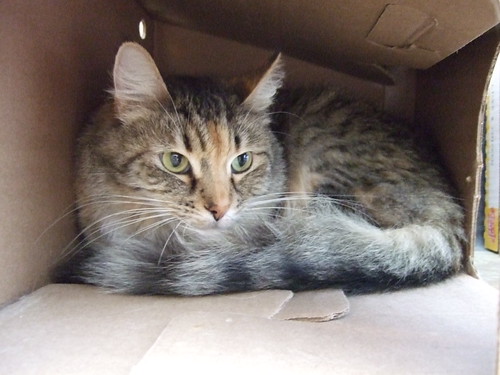
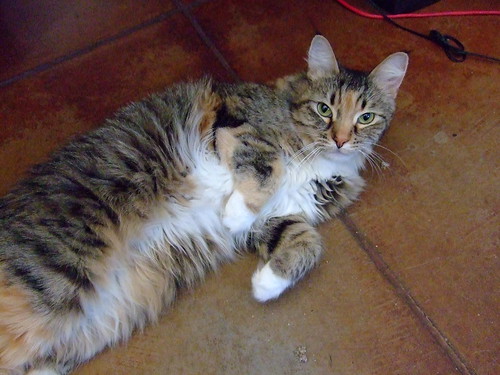


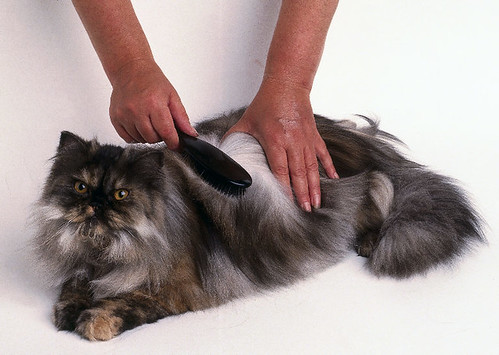
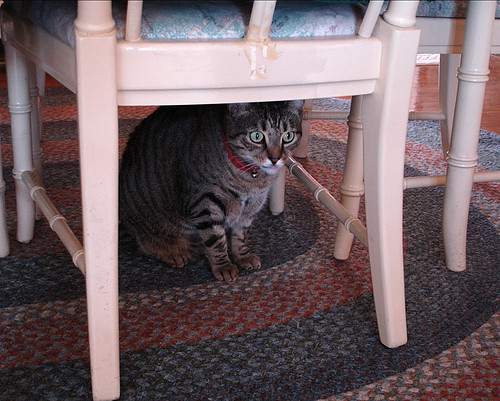
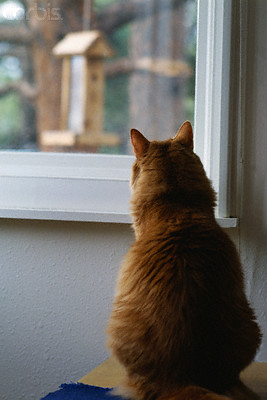
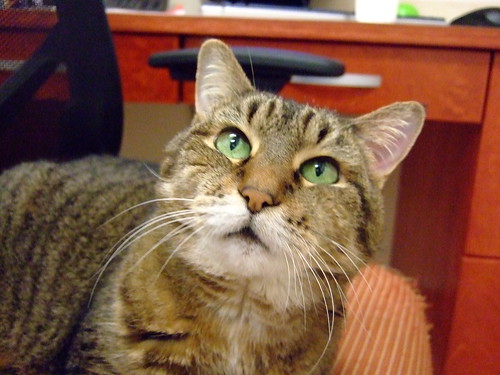
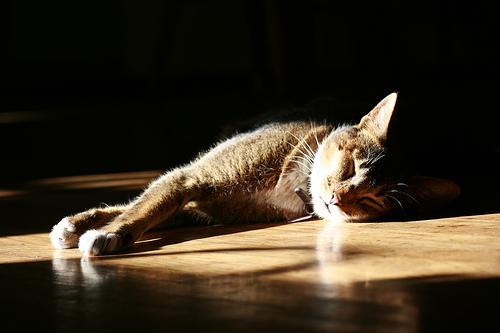
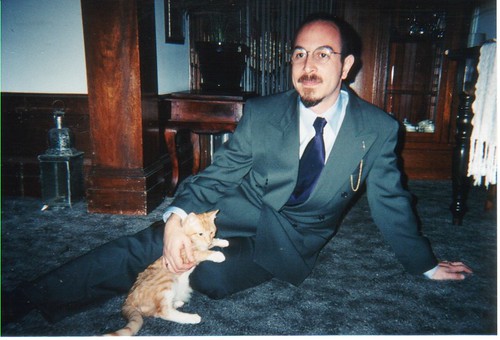
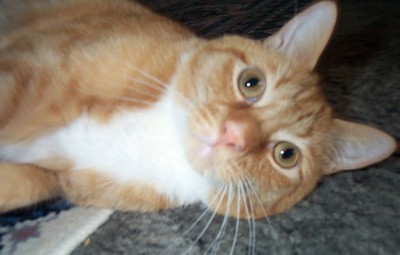

![DanielandSpumoni[1]](http://farm3.static.flickr.com/2622/3708520008_25bc1de7f1.jpg)
